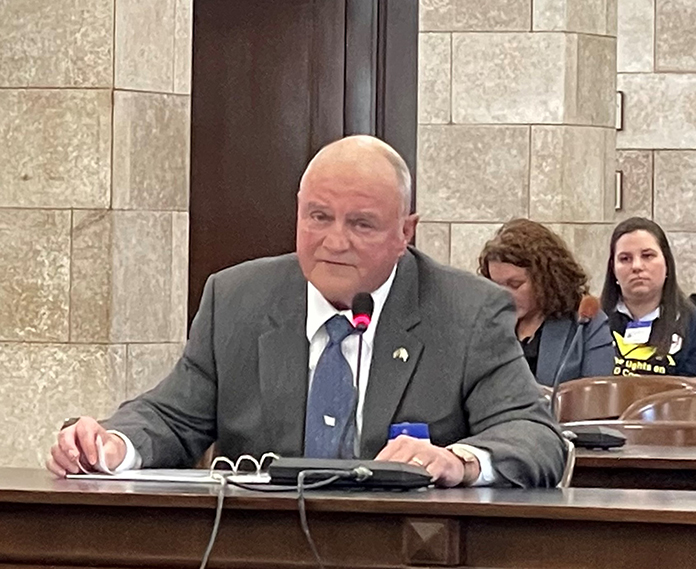
TOMS RIVER – The State Senate passed a bill that would add a one-time funding boost to districts hurt by the latest state aid reductions, but it remains to be seen how or when the funds will be delivered.
The Senate passed S-3732 on March 20. Out of the 40 state senators, 36 voted for the measure and 4 didn’t vote.
If a school district suffered from a reduction in aid under S-2 for the 2023-2024 school year, they would receive 66% of the cut aid back, according to the bill. It appropriates $102,784,455 toward that goal. The money is coming from the Property Tax Relief Fund.
The Assembly version, A-5328, has only just been introduced. An official said that this version will go to a vote on March 30 and that the governor has said he will sign it if it goes to his desk.
This additional money would be Supplemental Stabilization Aid, and it would only be a one-time award. A district will have to write to the Commissioner of Education with a plan on how they will use the fund, and how they will manage in future years if they don’t get the same kind of stabilization again.
Many districts lost aid consistently since 2018 due to a funding formula referred to as S-2.
The Toms River district had been anticipating a loss of aid in the amount of $2,688,937. Instead, it was cut by $14,421,851. The aid for the upcoming school year will be $30,978,802. This is about a 33% reduction from last year.
Toms River Mayor Mo Hill testified before the NJ Senate Budget and Appropriations Committee the morning of the vote to support this additional aid.
“We in Toms River are very appreciative of the funding you will hopefully provide today. With the $9.5 million being restored to Toms River Regional Schools, we now have a $4 million problem instead of the insurmountable $14.5 million problem,” he said.
“Toms River Regional has suffered over $60 million in cuts via S-2 over the last five years. Spending has already been cut to the bone. Our class sizes are already too high at 30 students per class. Our surplus and emergency funds are gone. This year we are paying some teachers’ salaries with federal COVID funds, which as you know, will not be recurring. Along with several other school districts we have requested the release of the S-2 formula and data however that information has not been provided. It is increasingly difficult to explain these severe cuts to our students, parents, teachers, staff and residents without that data,” he said.
The concept behind S-2 was that overfunded and relatively rich districts saw cuts in aid. Hill explained that these numbers don’t add up. The median household income is a little over $85,000. This makes Toms River middle class.
“I understand that the S-2 formula punishes districts that were overfunded in the past. Punishing children and teachers today, in 2023, for mistakes made by administrators, on both the State and local level 10-15 years ago makes no sense. It is cruel and ridiculous. It cannot be what the legislature intended when S-2 was passed,” he said.
“I’ve been told that property values are a component of the wealth test. Like much of the Jersey Shore, our real estate values soared during the COVID-19 pandemic as people fled New York. But these increased real estate values do not translate into increased tax dollars for education,” he said.
“Our superintendent and Board of Education are now faced with cutting extracurricular programs and staff, like our excellent athletic programs. The 2022 Toms River North Mariners were the first football team in the history of New Jersey to go 14-0 while winning the State Class 5 Championship, setting the all-time scoring record and finishing No. 3 in the state – the highest ranking of any New Jersey public high school. The majority of the players are returning for the 2023 season and the cuts could affect the coaching staff. Neither Superintendent Mike Citta or I want to see that happen as it penalizes these student athletes,” he said.
“I don’t believe that this is what you intended when you passed S-2. But S-2 doesn’t work and it is driving good school districts to the brink of bankruptcy,” he said. “This problem cannot be solved by increasing property taxes. The district is constitutionally prohibited from raising property taxes by more than 2% to meet the thorough and efficient threshold, even if the taxpayers consented via referendum because thorough and efficient is prohibited from being put to referendum.”
Another factor in the funding formula is enrollment. Schools that were losing students were losing aid.
According to district figures, there were 15,622 students in the 2017-2018 school year, just before S-2 went into effect. The projected enrollment for 2023-2024 is 14,764. This represents a 5.5% decrease in enrollment lined up with a 55% decrease in state aid.
The aid in 2017-2018 was $68.3 million and next year, if nothing changes, it will be $31 million.
One thing that the enrollment doesn’t take into account is that not all students need the same amount of help. There were 170 students in 2017-2018 who had English as a second language, compared to 652 today and 573 projected for 2023-2024.
In 2017-2018, there were 4,511 students who qualified for free and reduced lunch programs. That is expected to grow to 4,760 for 2023-2024.
In 2017-2018, there were 2,310 special education students. That is expected to grow to 2,625 in 2023-2024.
“Enrollment is a key factor of the S-2 formula, as it should be,” Hill said. “Toms River’s enrollment declined, especially after Superstorm Sandy. We were ground zero of Sandy. Here we are 11 years later and we are still recovering, but we are almost fully recovered and we are more resilient. Our enrollment is starting to grow and we have an influx of ELL and SE students enrolling in the district.”
“Toms River Regional is one of the most efficient of the thorough and efficient districts in the state. We spend less than $14,000 per student. Our graduation rate is 93% and our test scores are high. We receive a little over $2,200 per student (in aid) while districts smaller than ours receive between $35-40,000 per student,” Hill said.
“I encourage you to reform the education formula which has left our district with a structural deficit. We have no way to legally close the gap,” he said. “New Jersey needs a school funding formula that is transparent, easy to understand, and that is fair to all children and communities in the state.”
He also thanked Senator Vin Gopal, Chairman of the Senate Education Committee, for the work he has done with Superintendent Michael Citta as well as township staff. Gopal, a Democrat, was thanked for working across the aisle and sponsoring this bill.






